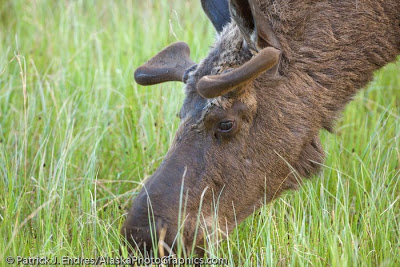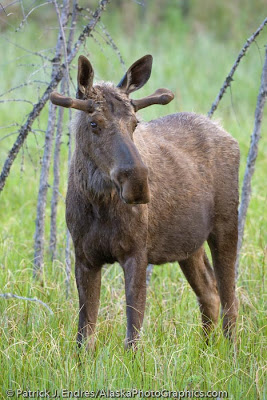On a trip into the Alaska range, about 150 miles from Fairbanks, I saw more than 10 moose feeding along the roadside about 9-10:30pm or so. Interestingly, they were predominantly young bulls. Those that travel the roads in Alaska realize that the observation of bull moose along the highways diminish considerably as the summer progresses. I believe this is for a particular reason, namely the rich green spring grasses, often growing in the open areas along the road, offer that vital nutrients needed to cast those extensive antlers that grow so quickly. The willow leafs have not opened yet, (a favorite food of the moose), so they are opportunistically feeding.
 Young bull moose feeds on spring grasses along the Alaska Highway Canon 1Ds Mark III, 500mm f4L, 1/80 sec @ f6.3, ISO 640
Young bull moose feeds on spring grasses along the Alaska Highway Canon 1Ds Mark III, 500mm f4L, 1/80 sec @ f6.3, ISO 640As the green growth unfolds throughout the tundra and taiga, moose browse more preferentially, in obscure, protected areas, consuming huge quantities of vegetation. The velvet that encases the moose antlers (antlers are made of bone and horns are made of a keratin substance) encase blood vessels that richly nourish their growth and development. Generally, bull moose are rarely seen again until autumn (late August/September) when the mating season motivates them to pursue mating dominance. At this time, antlers are fully grown, and the nourishing sheath of velvet is rubbed off to reveal textured antlers of bone. The focus on food shifts to mating!








